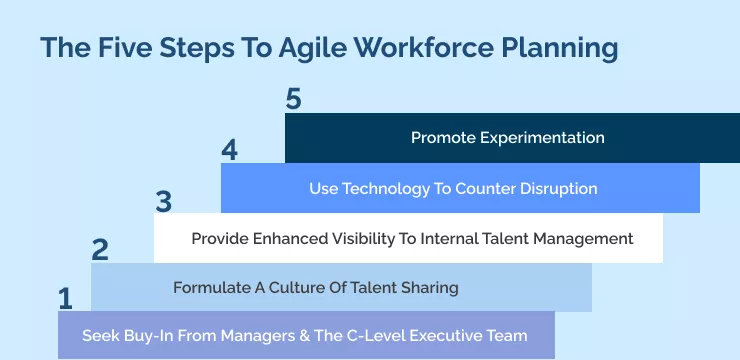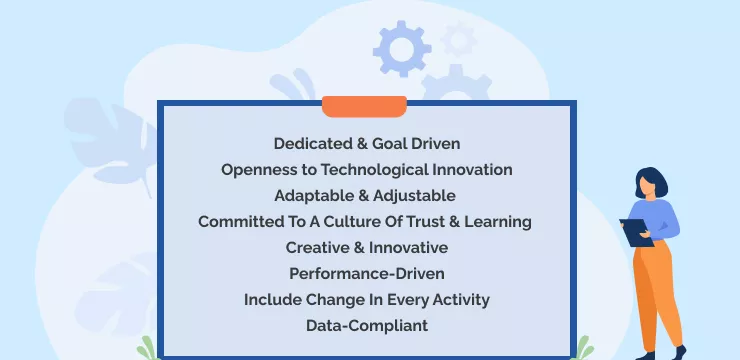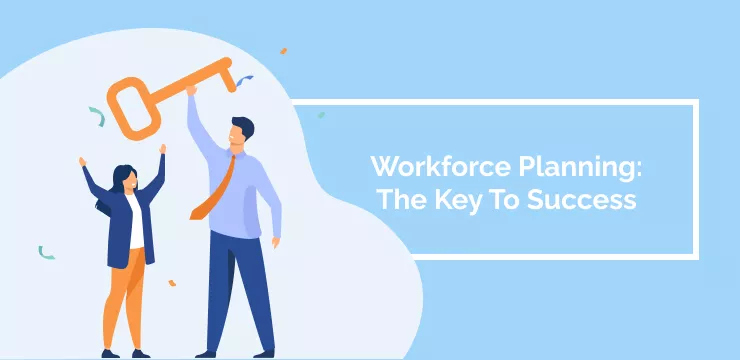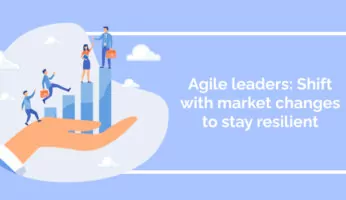
Agile workforces are experts at dealing with new challenges of today’s business landscape by transforming disruptive change into productivity. The employees driving this new world of business are flexible. It is crucial for companies today to consider what they can do to ensure their workforce remains agile to deal with the current challenges of today’s market.
But what is an agile workforce? What are the five steps to agile workforce planning? And what are the characteristics to consider when creating your agile workforce? Answers to these questions appear below, beginning with the definition of the agile workforce.
What Is An Agile Workforce?

“Out of 22 organizations in 6 sectors, agile organizations reported a 20-30% increase in financial performance.” McKinsey
It is best to look at different companies and how they have changed over time to define agile workforces. When businesses such as the Ford Motor Car Company began in 1910, it used all human staff working in a small factory.
Ten years later, Ford had a 60% worldwide automobile market share. Over this period, Ford had to reassess how it made cars and the price it would charge. As a result, workforce planning radically shifted over this time to take us to today.
In the car industry today, part of the workforce has been replaced with machinery. This disruption required another section of the workforce to maintain and upgrade this machinery. Today, the workforce comprises many elements, such as permanent staff working full time, temporary staff working on fixed-term contracts, and often with specialist talents.
An agile workforce promotes employee engagement. Practicing this concept allows a workforce to remain agile and react to technology disruption and marketplace changes. Agile workforce planning must always engage new and established staff to uncover hidden talent within their organization.
The Five Steps To Agile Workforce Planning

There are five steps to agile workforce planning, and leaders must follow each process stage to ensure a workforce becomes and remains agile for the highest customer satisfaction. The first of these five steps is to seek buy-in from the C-level executive team. Agility leaders can repeat some of these when obstacles appear or repeat all the steps as part of an annual agile workforce planning audit.
1. Seek Buy-In From Managers & The C-Level Executive Team
Agile teams exist within agile organizations. The CEO of an organization needs to seek buy-in from managers and c-level executives so they can share the vision of clear goals with team members.
The shared goals must create customer value to attract them to a company. The goals should achieve this by prioritizing customer centricity to understand the broad array of customer needs throughout the customer journey. In addition, value needs to be created not just to attract customers but for all stakeholders. This set of goals includes entire communities, employees, partners, and external partners, such as investors.
Creating value for shareholders is achieved by including them in the value creation system. Examples exist in modular products and solutions in manufacturing, agile supply chains in distribution, and platform businesses such as Uber, Airbnb, and UpWork. These companies have a modular structure, allowing them to move resources quickly and efficiently.
Companies Tesla, Google, and Haier, hold the gold standard for allocating resources. These companies achieve such flexible resource management skills by constantly reassessing their position in the industry and looking to the future for what disruption they may need to manage next. This flexibility is the key to workforce agility and begins with the managers and c-level executives teaching new skills to team members to achieve a competitive advantage.
2. Formulate A Culture Of Talent Sharing
To become part of agile organizations, leaders need to give teams clear direction and visible leadership to whom they can refer for questions or support during challenges. Clear direction leads to groups supporting each other and sharing skills during collaborative practices, which become the status quo in an organization’s culture. CEOs can achieve this by keeping the highest level of the hierarchy but replacing the lower levels with a flexible, scalable system of teams.
The best technologies to invest in to improve workforce agility focus on real-time communication and work management. The modular software architecture allows greater flexibility as managers can scale software instantly to fit a changing company’s needs and modules added and removed as required. Customer needs are constantly changing, so modular software’s flexibility leads to improved customer satisfaction.
Hackathons, virtual collaboration, and crowdsourcing are excellent tools for understanding the needs of a target market. Departments using automated testing procedures and deployment enable continuous, seamless, lean software releases to the business market. IT specialisms can work collaboratively. One example is IT development and operations teams working together to create more efficient handover-free DevOps practices.
3. Provide Enhanced Visibility To Internal Talent Management
People are at the heart of a successful agile workforce plan. Staff from different departments and disciplines must be encouraged, trained, and confident to take responsibility for tasks and decisions. Agility leaders promote this autonomy to promote dynamism in staff as they become motivated about driving their learning and workflow.
Shared values are reinforced through positive reinforcement in a safe, secure environment based on trust. Rules and hierarchy are removed, making way for a more level field of communication and influence.
When employees are stimulated and feel they are fulfilling more than just a job, there is minimal gossiping and a low employee turnover, and a positive culture is in place. Multiple skill sets must be encouraged via cross-departmental working and internal mobility within departments.
HR departments must identify talent shortages early to initiate recruitment campaigns to attract top talent. Most organizations today implement continuous recruitment programs to fill new positions. Doing this also diversifies an organization’s business skills and maximizes resources.
4. Use Technology To Counter Disruption
Disruption today is technological, mainly due to the speed of scientific research leading to constant technological breakthroughs. Therefore, investing in new technologies helps to counter disruption before it occurs.
Using technologies makes organizations more robust against competition as they evolve parallel to changing technologies. The use of technology also aligns with talent sharing as new technology enhances cross-departmental collaboration and sharing of skills.
5. Promote Experimentation
It is difficult to predict the best way to react to disruption. An ongoing positive attitude toward experimentation is the only way to ensure an agile organization develops an agile workforce. The best way for organizations to promote this culture of experimentation is to teach staff to make decisions and learn from them quickly. This culture also creates a stimulating work environment, enhancing the employee experience.
The Defining Characteristics Of Workforce Agility

“Agility combines speed and stability; helps role clarity, innovation, and operational discipline; and can produce positive outcomes for organizational health and performance.” McKinsey
Agility leaders can use the characteristics of workforce agility to ensure their workforce plan will be successful. The first of these workforce agility characteristics is a dedicated and goal-driven organization.
Dedicated & Goal Driven
Organizations that successfully engage with the agile workforce plan are not just clear about how they implement it but why. Goals, KPIs, and objectives are all essential to ensuring an organization is composed of performance-driven, agile workers.
Openness to Technological Innovation
Digital transformation is a large part of the agile workforce, as technology forms the core reason for agility; Most business disruption is technology-based. All departments need to invest in apps like Slack and Zoom while team managers constantly research what more efficient, cheaper alternatives might be available in the future.
Adaptable & Adjustable
Cloud working has changed the face of business as we know it. The emerging hybrid workforce has transformed how employees engage with their organization, being available part of the time in the office and part of the time at home. Agile organizations need to ensure that they make all available technological and policy adjustments to get the most out of new cultures and technologies without being swept away by disruption without realizing it.
Committed To A Culture Of Trust & Learning
Trust will only come with positive work culture, and self-driven, continuous learning can only be successful when staff feels that their well-being is their organization’s top priority. All of these concepts are undeniably linked. There are many ways to promote a culture of trust and learning.
Firstly, change risk aversion to a motivation to encounter the unknown and learn something new. This change drives innovation and shows all staff that leaders trust them to make decisions independently, as this is the most meaningful way to learn.
Finally, for employees to learn, they need to have the mental and physical energy to do so. Employee well-being must be the priority within an agile workforce. Leaders must acknowledge this for themselves and their team members.
Creative & Innovative
Creativity is within every agile decision at any level. Creativity can lead to innovation, as clients constantly make significant changes in short periods, and organizations do all they can to keep up. Radical change should always be encouraged within a framework to get the best out of resources.
Performance-Driven
With many variables for where and when the agile workforce operates, the focus should always be on performance. Metrics can lead to insights into the best ways team members use. Managers can then disseminate this information to staff to encourage them to engage in the best practices for maximum output.
Include Change In Every Activity
Change is at the core of an agile workforce. Agile workforces must not simply accept change but include it in every activity or as many activities as possible in everyday routines. Individuals drive organizational change, so promoting change as part of an organization’s culture is the best way to encourage change at an individual level to make it part of an organization’s identity and philosophy.
There are three easy-to-implement means of encouraging change in the everyday. The first is to schedule regular appraisals and other performance measures. The second is to offer bonuses and add performance-based pay into policies. And the third is to practice a management style of delegation and empowerment.
Data-Compliant
GDPR means that organizations have a responsibility to safeguard sensitive staff information. Agile workforces embrace many technological advances, such as the cloud, which comes with data-compliance risks. Safeguarding responsibilities are even more fraught when organizations use the cloud, as data is more vulnerable when placed in the hands of a third party.
Agile organizations must ensure that all innovations are safe and compliant before investing.
Create An Agile Workforce In Three Steps
Creating an agile workforce can be simple if you follow three steps. The first step is to cultivate a growth mindset.
- Cultivate A Growth Mindset
The organization also grows when agility leaders encourage individuals to develop and grow within a team and organization. Learning through experimenting with approaches to tasks is one way to do this. Encouraging staff to seek extra training and skills for which they can be awarded by their organization and offered additional funding is another positive way to cultivate a growth mindset at individual and organizational levels. Extra training also provides other tools to gain insights into how to deal with disruption in business and the process by which this occurs.
- Encourage An Open Mindset
There are many different means of innovation, which can be crucial for a resilient organization. Encouraging an open mindset toward new approaches to challenges is an effective way of promoting innovation culture. A culture where staff does not ridicule any question or answer and all points are considered valid often leads to innovations providing a crucial edge against competitors.
- Foster A Promotion Mindset
An agile workforce with a promotion mindset focuses on winning against the competition and gaining. This mindset allows employees to engage with change differently from how a prevention mindset might block employees from seeing the potential for success. The agile workforce exists within a world of willingness for promotion and development.
Workforce Planning: The Key To Success

An agile workforce plan can bring many benefits to an organization. The largest of these advantages is that an agile workforce exists within an agile organization, so these two worlds benefit and develop one another. Agility is essential to today’s market as it should characterize every business decision. Technology-driven innovation is at the heart of the need for agility, but the staff drives the innovation and change.
Within such successful agile workforces, change is not only managed but created, predicted into the future, and manipulated for the company’s gain. Approaching disruption with an agile workforce allows any company to improve employee productivity and learning, emerging successful.
Tristan Ovington
Tristan Ovington is a professional senior writer and journalist, specializing in providing expert insights on various topics such as digital adoption, digital transformation, change management, and Cloud apps. He delivers his knowledge through accessible online content that is data-driven and presented in a friendly tone, making it easy for readers to understand and implement.


